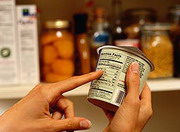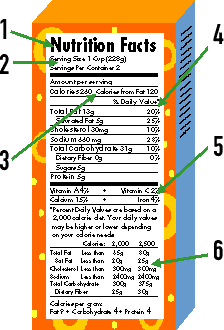Once upon a time, words like "light" and "low-fat" on food packages had no real nutritional meaning. As a result, shoppers were often led to believe they were buying products that were more healthful than they actually were. Nutrition information labels were also confusing and hard to read. But the Food and Drug Administration (FDA) changed all that.

In the early 90's, the FDA defined and standardized terms that appear on food labels, such as "low-fat," "reduced" and "lean," to restrict how food manufacturers could tout their products. Nutrition labels were overhauled too. The latest format is easy to read and carries facts that are relevant to most of our dietary needs. Here is an outline of the most important changes and how they can help you make the best choices at the supermarket.
At Last, Food Labels That Mean What They Say
Before May 8, 1994, a food product claiming to be "light" could just be light in color, texture or taste. But now such creative--and often misleading--labeling jargon is regulated. Terms used on the new food labels must adhere to the following FDA definitions:
- Light means that the food has half the fat, one-third the calories or half the salt of its regular counterpart. It can still be used to describe other properties like color or texture as long as the label makes the distinction clear (for example, "light brown sugar" or "light and fluffy").
- Free, as in fat-free or sugar-free, indicates that none of the substance cited (or only a negligible amount) is in the product. For instance, a calorie-free product must have fewer than five calories per serving, while fat-free and cholesterol-free foods should have less than half a gram per serving. Related words, such as "without," "no" and "zero," must meet the same standards.
- Low may be used on products that do not exceed the dietary guidelines for fat, saturated fat, cholesterol, sodium or calories. The criteria they must meet are:
- Low-fat: 3 grams or less per serving
- Low-saturated fat: 1 gram or less per serving
- Low-sodium: 140 milligrams or less per serving
- Low-cholesterol: 20 milligrams or less of cholesterol and 2 grams or less of saturated fat per serving
- Low-calorie: 40 calories or less per serving
- Lean can be used to describe the fat content of meat, poultry and seafood. To be called "lean," a serving of the product must have less than 10 grams of fat, 4.5 grams or less of saturated fat, and less than 95 milligrams of cholesterol. "Extra lean" has also been defined to mean less than 5 grams of fat, less than 2 grams of saturated fat and less than 95 milligrams of cholesterol.
- Reduced means that a nutritionally altered product contains at least 25 percent less of a nutrient or of calories than the regular product.
- Less and fewer can be used to describe foods that have a nutrient or calorie content which is reduced by at least 25 percent.
- High, as in high-fiber, means the product has 20 percent or more of the daily value for the nutrient cited.
- Good source indicates that one serving of the food contains 10 to 19 percent of the daily value for a particular nutrient.
What About Health Claims?
Many provocative claims are made regarding the ability of nutrients to prevent certain diseases. Food manufacturers, however, are now only allowed to make the following well-established claims concerning relationships between diet and disease:
- Calcium and a reduced risk of osteoporosis.
- Fat and increased risk of cancer.
- Saturated fat and cholesterol and an increased risk of heart disease.
- Fiber and a reduced risk of cancer.
- Fruits, vegetables and grain products that contain fiber and a reduced risk of heart disease.
- Sodium and an increased risk of high blood pressure.
- Fruits and vegetables and a reduced risk of cancer.
- Soy protein and a reduced risk of heart disease.
Armed with this new knowledge, you can make healthier food choices on your next trip to the supermarket. If only someone could regulate our will power to stick to those healthier choices!
What's on the Labels?
The nutrition information format has been redesigned to help consumers make healthier choices when buying packaged foods. Fresh or raw foods will not have to be labeled as long as retailers voluntarily display nutritional information for the top selling fruits, vegetables and meats at the point of purchase.

- The new heading signals that the label contains the newly-required information.
- Serving sizes are no longer up to the manufacturer. They are based on surveys of what people actually eat in 139 different product categories. For example, in the past 30 grams of a bag of cookies may have been considered a single serving. Now a serving would be two cookies.
- Calories from fat are now shown to help consumers meet dietary guidelines that recommend we get no more than 30 percent of our calories from fat each day.
- The % Daily Value shows how much of each nutrient a food provides compared with how much of that nutrient is needed each day. These calculations are based on a 2,000-calorie diet. People who consume more or less have to figure out the percentages themselves. A serving of this sample product contains 5 percent of the daily value for fat. The FDA suggests you look for 5 percent or less of fat, cholesterol and sodium in any individual food.
- The list of nutrients covers those most important to the health of today's consumers, who need to worry about getting too much of certain items (like fat) rather than too few of the vitamins and minerals that the old labels emphasized. Nevertheless, manufacturers must list vitamins A and C, calcium and iron. They may also include any other nutrients they feel are important.
- Daily Values (DVs), replace the old U.S. Recommended Daily Allowances (U.S. RDA's). They also set official recommendations for total fat, saturated fat, cholesterol, sodium, carbohydrate and fiber. DVs are based on a 2,000-calorie daily diet.
 In the early 90's, the FDA defined and standardized terms that appear on food labels, such as "low-fat," "reduced" and "lean," to restrict how food manufacturers could tout their products. Nutrition labels were overhauled too. The latest format is easy to read and carries facts that are relevant to most of our dietary needs. Here is an outline of the most important changes and how they can help you make the best choices at the supermarket.
In the early 90's, the FDA defined and standardized terms that appear on food labels, such as "low-fat," "reduced" and "lean," to restrict how food manufacturers could tout their products. Nutrition labels were overhauled too. The latest format is easy to read and carries facts that are relevant to most of our dietary needs. Here is an outline of the most important changes and how they can help you make the best choices at the supermarket.

